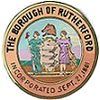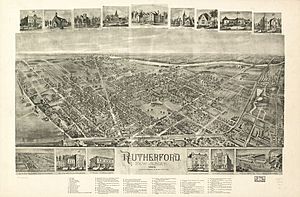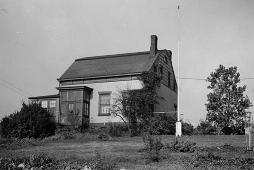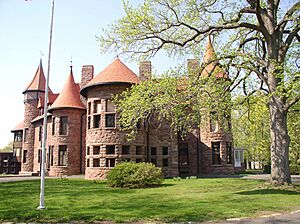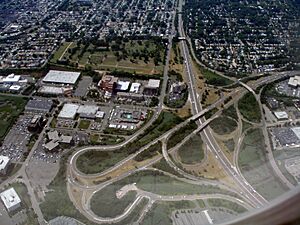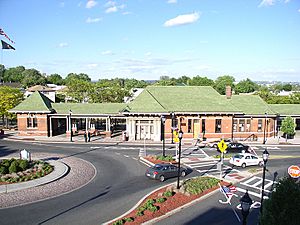Rutherford, New Jersey facts for kids
Quick facts for kids
Rutherford, New Jersey
|
||
|---|---|---|
|
Borough
|
||
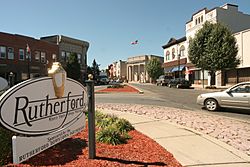
The ‘Welcome to Rutherford’ sign
|
||
|
||
| Nickname(s):
"Borough of Trees",
"First Borough of Bergen County" |
||
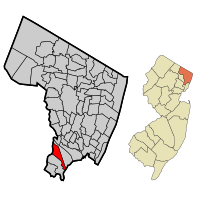
Location of Rutherford in Bergen County highlighted in red (left). Inset map: Location of Bergen County in New Jersey highlighted in orange (right).
|
||
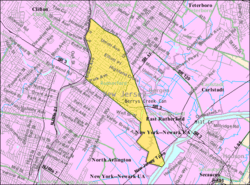
Census Bureau map of Rutherford, New Jersey
|
||
| Country | ||
| State | ||
| County | Bergen | |
| Incorporated | September 21, 1881 | |
| Named for | John Rutherfurd | |
| Government | ||
| • Type | Borough | |
| • Body | Mayor and Council | |
| Area | ||
| • Total | 2.89 sq mi (7.49 km2) | |
| • Land | 2.78 sq mi (7.20 km2) | |
| • Water | 0.11 sq mi (0.29 km2) 3.88% | |
| Area rank | 342nd of 565 in state 29th of 70 in county |
|
| Elevation | 66 ft (20 m) | |
| Population
(2020)
|
||
| • Total | 18,834 | |
| • Estimate
(2023)
|
18,852 | |
| • Rank | 146th of 565 in state 16th of 70 in county |
|
| • Density | 6,772.4/sq mi (2,614.8/km2) | |
| • Density rank | 72nd of 565 in state 22nd of 70 in county |
|
| Time zone | UTC−05:00 (Eastern (EST)) | |
| • Summer (DST) | UTC−04:00 (Eastern (EDT)) | |
| ZIP Code |
07070
|
|
| Area code(s) | 201 | |
| FIPS code | 3400365280 | |
| GNIS feature ID | 0885383 | |
Rutherford is a small town, called a borough, in Bergen County, New Jersey. It's known for its many trees, earning it the nickname "Borough of Trees." It's also called "The First Borough of Bergen County." The town has a lively downtown area that's great for walking, located right next to its train station.
As of the 2020 United States census, about 18,834 people live in Rutherford. The town was officially created on September 21, 1881. It was named after John Rutherfurd, a U.S. Senator who owned a lot of land in the area.
Contents
History of Rutherford
The land where Rutherford now stands was first settled by Lenape Native Americans. This was long before the first European settler, Walling Van Winkle, arrived in 1687. A road called Union Avenue might have been an old Native American trail.
In the early days, Rutherford was part of a larger area called New Barbadoes Township. This area changed counties and townships several times over the years. It was part of Essex County, then Bergen County, then Lodi Township, and even Harrison Township in Hudson County. Finally, in 1852, it became part of Union Township in Bergen County again.
A part of the area was known as Boiling Springs. This was because of a strong spring that flowed constantly. Even though it was called "boiling," the water was actually cold groundwater.
The Erie Railroad built its main train line through the area in the 1840s. In 1866, Daniel Van Winkle gave land for a train station at Boiling Springs. People would get off the train there to visit resorts along the Passaic River.
Much of Rutherford was farmland owned by the family of John Rutherfurd. Daniel Van Winkle helped sell this land. He also helped plan the streets of the new community.
By the 1870s, the area started to be called "Rutherford." The spelling of the name changed from "Rutherfurd" to "Rutherford." This might have been because of President Rutherford B. Hayes or a simple mistake by the Post Office. The Post Office opened a branch called "Rutherford" in 1876. On September 21, 1881, Rutherford officially became a borough. At that time, about 1,000 people lived there.
Historic Places to Visit
Rutherford has several places listed on the National Register of Historic Places. These are important sites that show the town's history:
- Iviswold – This beautiful castle was built in 1869. It was later expanded into a large, 25-room home. Today, it's on the campus of Felician College.
- Kip Homestead – An old homestead located at 12 Meadow Road.
- Rutherford station – The train station was built in 1898. It has been renovated to bring back its original look.
- William Carlos Williams House – This was the home of the famous poet William Carlos Williams.
- Yereance-Berry House – This house is now home to the Meadowlands Museum.
Geography of Rutherford
Rutherford covers about 2.89 square miles (7.49 square kilometers). Most of this area is land, with a small part being water.
Rutherford is located about 8 miles west of Midtown Manhattan in New York City. This makes it a close neighbor to the big city.
The borough has natural borders. The Passaic River is to the west, separating it from Clifton and Passaic. The Erie Railroad is to the north and east, bordering East Rutherford. The Hackensack River is to the southeast, bordering Secaucus. And Berrys Creek and Rutherford Avenue are to the south and southwest, bordering Lyndhurst.
People of Rutherford
| Historical population | |||
|---|---|---|---|
| Census | Pop. | %± | |
| 1880 | 2,299 | — | |
| 1890 | 2,293 | −0.3% | |
| 1900 | 4,411 | 92.4% | |
| 1910 | 7,045 | 59.7% | |
| 1920 | 9,497 | 34.8% | |
| 1930 | 14,915 | 57.0% | |
| 1940 | 15,466 | 3.7% | |
| 1950 | 17,411 | 12.6% | |
| 1960 | 20,473 | 17.6% | |
| 1970 | 20,802 | 1.6% | |
| 1980 | 19,068 | −8.3% | |
| 1990 | 17,790 | −6.7% | |
| 2000 | 18,110 | 1.8% | |
| 2010 | 18,061 | −0.3% | |
| 2020 | 18,834 | 4.3% | |
| 2023 (est.) | 18,852 | 4.4% | |
| Population sources: 1880–1920 1880–1890 1890–1910 1890–1930 1900–2020 2000 2010 2020 |
|||
Rutherford's Population in 2020
In 2020, Rutherford had 18,834 people living in 6,835 homes.
- About 71.3% of the people were White.
- About 16.2% were Asian.
- About 2.3% were Black or African American.
- About 7.7% were of two or more races.
- About 22.7% of the total population was Hispanic or Latino.
More than half of the residents (50.6%) were female. About 24.5% of the people living in Rutherford were born in another country. Most adults (95.0%) had at least a high school diploma. Many (51.9%) had a college degree or higher.
Economy
Rutherford is home to some businesses. Architectural Window Manufacturing Corporation has a plant here. Blue Foundry Bank, which used to be Boiling Springs Savings Bank, has its main office in Rutherford.
There are also plans for new developments in the area. One project, called Highland Cross Development, aims to build new homes, hotels, and shops.
Arts and Culture in Rutherford
Rutherford has a rich artistic and cultural history.
William Carlos Williams, a famous Pulitzer Prize-winning poet, was born in Rutherford in 1883. He lived and worked as a physician in his house at 9 Ridge Road for most of his life, while also writing his poetry.
The Rivoli Theatre opened in 1922 as a place for live shows. It soon became a movie theater. After a fire in 1977, it was restored and reopened in 1981 as the William Carlos Williams Center for the Performing Arts. Today, it shows movies and hosts concerts, ballet, opera, and theater for children.
The Meadowlands Museum teaches about local history. It started in 1961 and moved to the Yereance-Berry House in 1974.
The GFWC Woman's Club of Rutherford is a volunteer group that started in 1889. They are located in the old Iviswold carriage house.
The Rutherford Community Band started in 1941. They play free concerts in different places around town, including Lincoln Park.
Yearly Events
Rutherford has several fun events each year:
- The annual street fair on Labor Day is the longest-running street fair in New Jersey. It usually attracts about 20,000 people.
- The Rutherford West End Festival started in 2009.
- The Rutherford Multicultural Festival celebrates different cultures with entertainment and food from around the world.
- The Rutherford Downhill Derby started in 2017. Kids and adults can build and race gravity-powered carts.
- The Rutherford Pride Alliance was founded in 2018. In 2019, they raised the LGBTQ Rainbow flag to celebrate the 50th anniversary of the Stonewall riots.
Parks and Recreation
Rutherford has many parks for outdoor activities.
Rutherford Memorial Park is a large park with 30 acres. It has:
- Two baseball diamonds
- Five softball diamonds
- A Little League Baseball field
- A football stadium
- Six tennis courts
- Two basketball courts
- Three playgrounds
Other parks include Tamblyn Field, which is good for active sports.
The borough also has smaller, quieter parks:
- Lincoln Park is across from the borough hall. It has a band shell and monuments, including a cannon from the Spanish–American War. It also has the town's 9/11 memorial.
- Sunset Park is on a steep hill and is being redesigned.
- Firefighters' Memorial Park is a small park at Park and Mortimer Avenues.
Lincoln Park hosts many town events, concerts, and memorials. The Rutherford Community Band plays concerts there in the summer. The borough also sponsors summer concerts and movie nights in the park.
The Nereid Boat Club is a rowing club located on the Passaic River. It started in 1875 and moved to Rutherford in 1996.
Emergency Services
Rutherford has dedicated teams to keep its residents safe.
Police Department
The Rutherford Police Department (RPD) helps keep the borough safe. It has 40 officers. The RPD responds to about 24,000 calls each year. They also investigate crimes. The police department started in June 1879.
Fire Department
The Rutherford Fire Department (RFD) is made up of all volunteers. It was started in May 1871. The department has one Chief, one deputy chief, and three assistant chiefs. There are five fire companies in three fire houses. About 75 trained firefighters work for the RFD. They use three Engines, a Ladder truck, a Heavy Rescue vehicle, a Special Service Unit, and two boats.
Ambulance Corps
The Rutherford First Aid-Ambulance Corps is also a volunteer service. It started in 1949. The corps has 40 members. They provide basic life support and are mostly certified Emergency Medical Technicians. They use three Type III ambulances.
Education
The Rutherford School District serves public school students from pre-kindergarten through twelfth grade. In the 2018–19 school year, the district had about 2,652 students in five schools.
The oldest school building still standing is the former Park School, built in 1902. It is now the Rutherford borough hall.
The schools in the district are:
- Kindergarten Center (opened in 2014)
- Lincoln School (Pre-K–3)
- Washington School (grades 1–3)
- Pierrepont School (grades 4–6)
- Union School (grades 7–8)
- Rutherford High School (grades 9–12), built in 1922.
Students in Bergen County can also attend special high school programs. These are offered by the Bergen County Technical Schools. This includes the Bergen County Academies in Hackensack and the Bergen Tech campus in Teterboro or Paramus.
St. Mary's Roman Catholic Church in Rutherford also has schools. The Academy at Saint Mary is for preschool through eighth grade. St. Mary High School was founded in 1929.
Fairleigh Dickinson University started in Rutherford in 1942 as a two-year college. Its main building was the Iviswold Castle. Later, the university grew and moved to other campuses. In 1997, Felician College, a private Catholic school, bought the Rutherford campus. They often host cultural events for the community.
Transportation
Rutherford has good transportation options, making it easy to get around and travel to other places.
Roads and Highways
Rutherford has about 46.84 miles of roads. Most of these are maintained by the borough itself.
In the 1920s, the original Route 17 went through downtown Rutherford. A new Route 17 was built in 1928, going around the edge of the borough.
In 1948, a new bypass road, Route S3 (now Route 3), was built. This road helps traffic from western towns reach the Lincoln Tunnel. Building this highway meant some homes in Rutherford had to be moved or taken down. The Route 3 bridge over the Passaic River was replaced in 2013.

A small part of the New Jersey Turnpike Western Spur (Interstate 95) goes through southern Rutherford. The closest exit is in East Rutherford.
Public Transportation
Rutherford became an early "bedroom community" because it was easy to get to New York City by train. Many homes were built in the 1920s.
Around 1900, Public Service Railway brought trolley lines to Rutherford. These trolleys connected Rutherford to Jersey City, Newark, Hackensack, and Passaic. By the late 1940s, buses replaced the trolleys.
After the Lincoln Tunnel opened in 1937, bus service began directly from Paterson to New York City. Today, NJ Transit offers bus service to New York City's Port Authority Bus Terminal. Several bus routes serve Rutherford, including the 163, 190, 191, 192, 195, and 76.
Rutherford's train station was built in 1898. It serves passengers on NJ Transit's Bergen County Line. You can take trains to Suffern and other stations. You can also go to Hoboken Terminal and connect to other trains, light rail, or ferries. From Secaucus Junction, you can connect to trains going to New York Penn Station and other places.
Notable People
See also
 In Spanish: Rutherford (Nueva Jersey) para niños
In Spanish: Rutherford (Nueva Jersey) para niños


